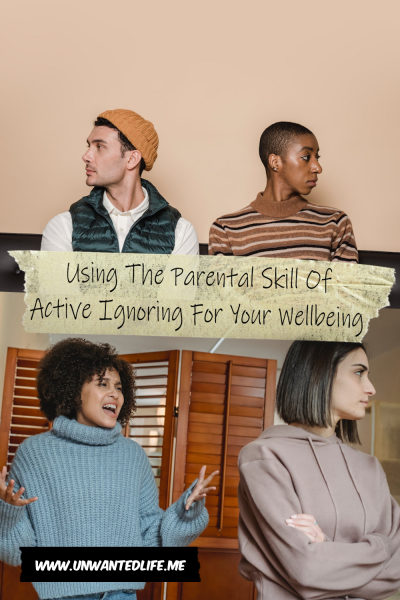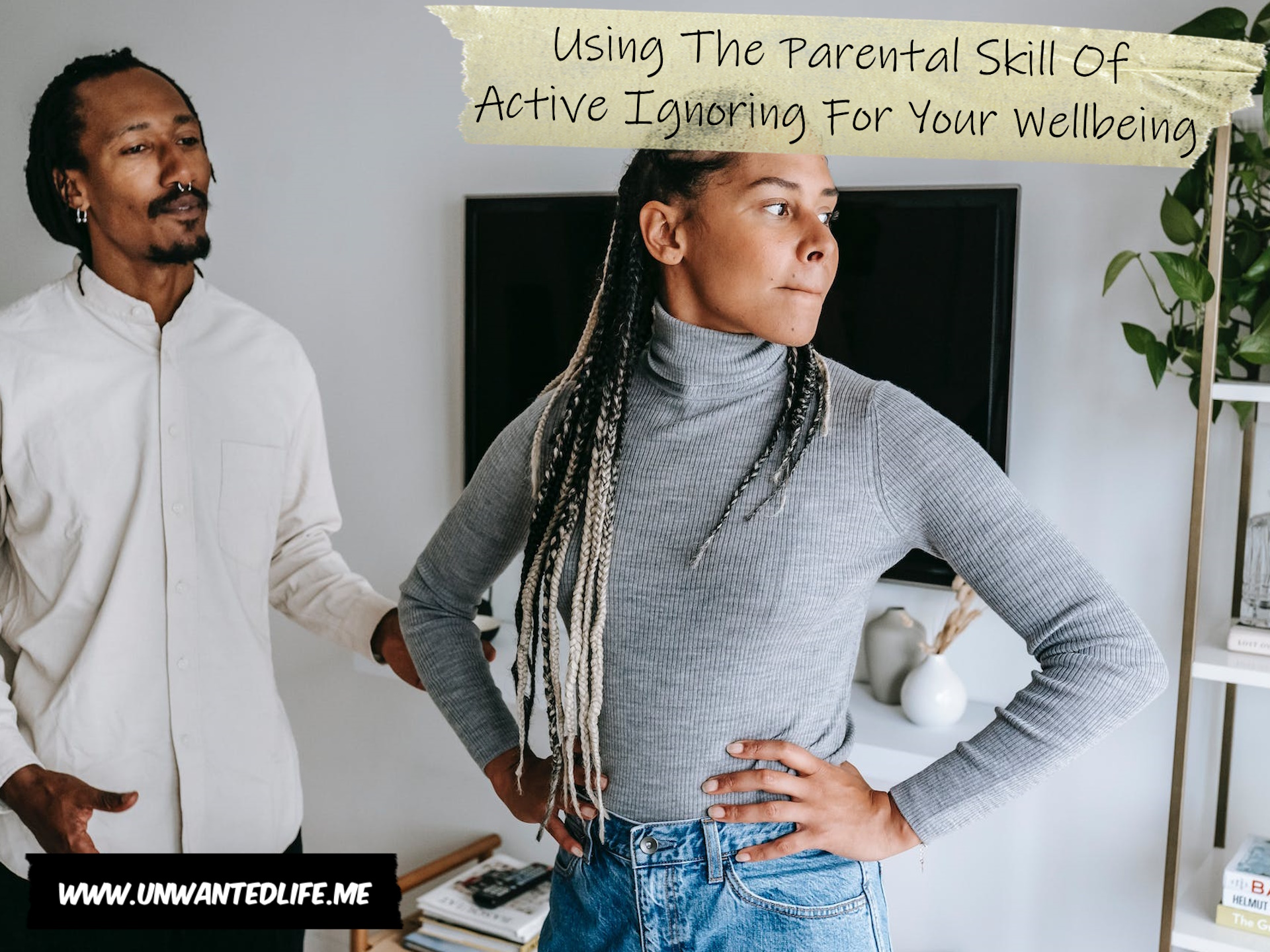A common issue I see people struggling with is how to avoid feeling overwhelmed and how to find the right work/life balance that works for them. By chance, I came across the parenting skill of active ignoring and I wondered how I could turn that into a wellbeing skill. This article is my attempt at just that. Let me know what you think.
What Is The Parental Skill Of Active Ignoring?
Active ignoring is a parenting skill that is often taught to parents because it’s been shown to help parents manage misbehaving children. It does that by teaching parents to briefly remove all attention from their misbehaving children, and by helping them avoid accidentally rewarding bad behaviours (Clark, 2005).
Children find attention from their parents very rewarding, but both positive and negative attention are rewarding to them. Thus, parent’s attention can be broken down into two types, according to the CDC. Positive attention is the kind of attention you give a child to let them know that what they’re doing is something you like. Whereas negative attention is where you give your child attention for something you don’t like.
Because of how hard it can be to be a parent and fit in all your other responsibilities, it can be easy for negative attention to become the most common form of attention. Meaning, that your child will learn that to get your attention, they need to do things you don’t like.
Therefore, if you give your child attention and tell them off while they’re having a tantrum, you are likely rewarding and reinforcing that behaviour (Clark, 2005). The child will learn that if they have a tantrum, then they will get your attention. Even if that attention is negative attention, it’s still attention. And I used the word attention a lot in that sentence. A better strategy might be to pretend to ignore the child by turning away from them and looking busy. Then, when their tantrum stops, you can give them all the attention you want.
Active Ignoring And The Behaviours Of Others
Active ignoring is a behaviour management technique often associated with parenting. But its principles can be applied to various situations, including interactions with non-parents, to promote wellbeing and maintain healthy boundaries. Here’s how you can apply active ignoring:
Identify the behaviours
Identify the specific behaviour that you want to address. This could be someone’s negative comments, constant complaints, or actions that make you uncomfortable. Think about what it is specifically about the behaviour that is causing you stress or anxiety. Consider whether the behaviour is intentional or unintentional. Once you know what the behaviour is and why it bothers you, it’ll make it easier for you to engage in active ignoring.
However, it’s also important to remember that active ignoring is typically used for behaviours that do not cause immediate harm but are disruptive or attention-seeking. If it is causing harm, then active ignoring might not be the best solution.
Redirection
Instead of responding directly to the behaviours that bother you, consciously redirect your focus to something positive or productive. This might involve engaging in a different conversation or activity.
Boundaries
Make sure to maintain your personal boundaries. Active ignoring doesn’t mean you should tolerate disrespectful or harmful behaviour. If the behaviour crosses a line, it’s essential to address it directly.
Reinforce positive behaviour
If the person’s behaviour changes in a positive direction, acknowledge and reinforce it. Provide attention and positive feedback when they exhibit desirable behaviours. Thus, when the person is not engaging in the unwanted behaviour, give them positive attention. This could be something as simple as smiling, saying hello, or making eye contact.
Use distraction
If possible, engage the person in another activity to redirect their focus when unwanted behaviours start. For example, if you have a coworker who is always gossiping about other people, you can ignore their gossip and avoid engaging with them about it, and switch the conversation to another topic.
Use nonverbal cues
In non-parenting situations, nonverbal cues can be effective. This includes maintaining eye contact when someone is behaving appropriately and briefly disengaging when their behaviour is undesirable. For example, if you have a family member who is always criticising you, you can ignore their criticisms and disengage from the conversation by looking away, only giving them eye contact when they talk about something else.
Be consistent
It is important to be consistent with active ignoring. If you only ignore the behaviour sometimes, it will not be as effective. It may get worse before it gets better as the person tries harder to get a reaction. Stick with the active ignoring.
Be patient
It will probably take some time for the person to learn that their behaviour is not getting a reaction from you. Be patient and consistent, and eventually, with luck, they will stop engaging in the unwanted behaviour.
Self-care
Although it sounds like it might be easy to just ignore someone, it can be surprisingly taxing. Ignoring someone can be emotionally draining, so remember to replenish yourself regularly with self-care. Practice self-care to manage your own emotions and stress, especially when dealing with challenging people. This might involve relaxation techniques, mindfulness, or seeking support from others.
Communication
If active ignoring doesn’t lead to an improvement in the situation, consider having a private and respectful conversation with the person. Explain your boundaries and express how their behaviour affects you.
Applying Active Ignoring For Better Mental Wellbeing
Stop doing list
Identify unhealthy or unproductive behaviours that you have that you want to ignore. This could be complaining, negative self-talk, attention-seeking, etc. and add them to your stop-doing list. A stop-doing list is similar to a to-do list, except it’s for stuff you don’t want to do, rather than tasks you want or need to do.
Just as active ignoring in parenting is a good way to avoid rewarding poor behaviours, it’s equally important to reward good alternative behaviours (Clark, 2005). You’re no different. If you want to make it easier to abandon bad behaviours and adopt new healthy ones, then healthy rewards are a good way to go.
It might also be beneficial to tell others your plan to actively ignore your own behaviours and explain why. Ask them not to draw attention to the behaviours as well, to stop you from engaging in them.
Using your attention wisely
Psychology Today suggests that if active ignoring is good enough for dealing with toddler tantrums, then it’s also good enough for ignoring calls, emails, and other notifications. Our attention is valuable, which is why social media companies try to keep us glued to their apps. Therefore, how you use your attention is valuable.
Thus, you could work out what things in your life are worth your attention and remove the ones that aren’t worth the attention they’re stealing. For example, if you find that social media is draining all your attention, but that you’re not happy with that, then you could take steps to reduce your social media usage.
Work/life balance
Another way this can be applied to improving your wellbeing is to apply active ignoring to out-of-work-hour communications. You’re not being paid to deal with work outside of work, so you’re under no obligation to do so. Unless it’s stipulated in your employment contract. Maintaining a healthy work/life balance is how you avoid burnout, and is one of the best forms of self-care you’ll ever come across.

Summary
Active ignoring is a technique that can be useful in some situations, but it may not be appropriate for all. If you’re using active ignoring to change unacceptable behaviours in others, then it should be employed with sensitivity and in a way that promotes positive interactions and wellbeing for all parties involved.
Active ignoring can be a helpful tool for improving your wellbeing. It can help you to reduce stress, anxiety, and negativity. If you are struggling with unwanted behaviours in your life, try using active ignoring to reduce them. And if you’re trying to address your work/life balance, then active ignoring can also be useful as well.
As always, leave your feedback in the comments section below. Also, please share your experiences with active ignoring in the comments section below as well. Don’t forget, if you want to stay up-to-date with my blog, then sign up for my newsletter below. Alternatively, get push notifications for new articles by clicking the red bell icon in the bottom right corner.
Lastly, if you’d like to support my blog, you can make a donation of any size below. Until next time, Unwanted Life readers.
References
Clark, L. (2005). SOS help for parents: A practical guide for handling common everyday behavior problems. SOS Programs & Parents Pres. Retrieved from https://files.eric.ed.gov/fulltext/ED384414.pdf.


Interesting, I’m not a parent but this would be good to take of wellbeing. Sharing this with my friend as he just became a parent to a baby.
I hope they find it useful as new parents and as a form of personal self-care
Active ignoring sounds like a good way to get things done.
Indeed
What an insightful read! This really got me thinking. I’ve done this as a parent but embracing this art of active ignoring as a parental skill is a game-changer for overall well-being. The ability to selectively focus on what truly matters fosters a healthier mindset and can help promote a more positive connection. I’ll be applying these valuable insights.
I hope this take on the approach proves beneficial. Thanks for commenting
I never thought about this before. Maybe I should try this on some of my toxic family members?
It certainly could help with managing toxic family members. I also have another article specifically on how to manage toxic family members that you might also find useful
https://unwantedlife.me/how-to-handle-toxic-family-members